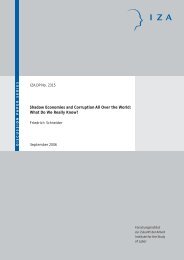Limited Self-Control, Obesity and the Loss of ... - Index of - IZA
Limited Self-Control, Obesity and the Loss of ... - Index of - IZA
Limited Self-Control, Obesity and the Loss of ... - Index of - IZA
You also want an ePaper? Increase the reach of your titles
YUMPU automatically turns print PDFs into web optimized ePapers that Google loves.
more than 30 percent in <strong>the</strong> United States (see figure 1). In <strong>the</strong> United States, adult obesity<br />
rates have more than doubled since <strong>the</strong> 1980s. In <strong>the</strong> year 2000, three in ten adults were<br />
classified as obese (Flegal et al. 2002).<br />
[Figure 1 about here]<br />
Overweight accounts for 10-13 percent <strong>of</strong> deaths <strong>and</strong> 8-15 percent <strong>of</strong> healthy days lost due to<br />
disability <strong>and</strong> premature mortality (DALY) in <strong>the</strong> European Region (World Health<br />
Organization 2002).<br />
A debate has started about <strong>the</strong> economic causes <strong>of</strong> this phenomenon, as well as its<br />
consequences (see, e.g., Cutler et al. 2003; Finkelstein et al. 2005; Rashad 2006). Increased<br />
obesity has been explained as <strong>the</strong> relationship between energy expenditure <strong>and</strong> energy intake.<br />
Energy expenditure is lower nowadays because manual labor has been replaced by more<br />
sedentary work due to technological changes (Lakdawalla <strong>and</strong> Philipson 2002). However, this<br />
trend started long before <strong>the</strong> obesity endemic took <strong>of</strong>f. The increase in calories consumed fit<br />
<strong>the</strong> obesity pattern better <strong>and</strong> is <strong>of</strong> sufficient magnitude to account for its increased prevalence<br />
(Putnum <strong>and</strong> Allshouse 1999). In particular, higher snack calories are responsible for higher<br />
energy intake for men, <strong>and</strong> for even higher energy intake for women (Cutler et al. 2003).<br />
What is <strong>the</strong> economic rationale behind <strong>the</strong> shifting energy household? Looking at relative<br />
prices suggests that, since <strong>the</strong> early 1980s, <strong>the</strong>re has been a decrease in price for calorie-dense<br />
foods <strong>and</strong> drinks compared to fruit <strong>and</strong> vegetables, which are less energy-dense (Finkelstein<br />
et al. 2005). These price reductions were made possible by new technologies in food<br />
production, in particular for prepackaged <strong>and</strong>/or prepared food. People have reacted by eating<br />
more frequently (snacking), eating bigger portions <strong>and</strong> spending less time on preparing meals.<br />
The question arises how <strong>the</strong>se increases in body weight, causing considerable harm to<br />
people’s health, are to be evaluated. Do people eat too much? What is <strong>the</strong> st<strong>and</strong>ard for “too<br />
much” if people can choose when <strong>and</strong> how much <strong>the</strong>y want to eat? Traditional economics<br />
advises us to resort to consumer sovereignty under such conditions. “Even with full<br />
information about <strong>the</strong> benefits <strong>of</strong> physical activity, <strong>the</strong> nutrient content <strong>of</strong> food, <strong>and</strong> <strong>the</strong> health<br />
consequences <strong>of</strong> obesity, some fraction <strong>of</strong> <strong>the</strong> population will optimally choose to engage in a<br />
lifestyle that leads to weight gain because <strong>the</strong> costs (in terms <strong>of</strong> time, money, <strong>and</strong> opportunity<br />
costs) <strong>of</strong> not doing so are just too high” (Finkelstein et al. 2005, 252). This might apply even<br />
more because health insurances <strong>and</strong> taxpayers finance a large amount <strong>of</strong> <strong>the</strong> monetary costs <strong>of</strong><br />
obesity. Moreover, obesity can be rationalized, assuming a high discount rate for future<br />
4
















